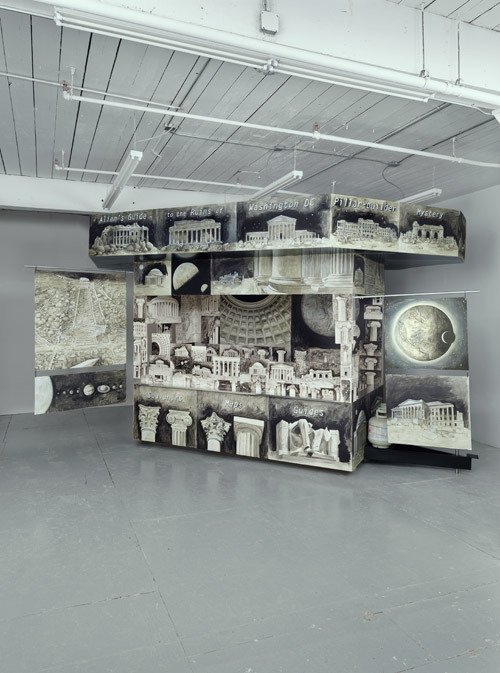Ellen Harvey
dal 2/7/2013 al 5/10/2013
Segnalato da
2/7/2013
Ellen Harvey
Corcoran Gallery Art, Washington
The Alien's Guide to the Ruins of Washington, D.C. New site-specific project. A tour of America's capital city through alien eyes, the exhibition's centerpiece is a self-guided map of Washington's landmarks.

Ellen Harvey’s new project is a glimpse into the world of the distant future. Human civilization having long-since come to an end, the earth is populated now only by ruins, ripe for archeological interpretation by visitors from another planet. Most immediately striking to these alien historians are the remains of the classical and neo-classical buildings that seem to have taken root in every corner of the globe.
Attempting to make sense of what they find, Harvey’s aliens immediately mine the potential of one of the greatest neo-classical cities—Washington, D.C.—as a tourist destination. The Alien’s Guide to the Ruins of Washington, D.C. is the result. A tour of America’s capital city through alien eyes, the exhibition’s centerpiece is a self-guided map of Washington’s landmarks. Available for pick-up at the Corcoran’s alien visitor center as well as other locations throughout the city, The Alien’s Guide contains reconstructions and interpretations of such sites as the White House, the World War II Memorial, and the U.S. Capitol.
The rest of Harvey’s exhibition follows the aliens’ attempts to interpret their findings. One of the Corcoran’s galleries is devoted to educating the alien children about the classical style around the globe, following its roots as a symbol of democracy in ancient Greece to its subsequent use in the service of empire builders, fascists, Stalinists, museums, banks, and post offices. Seduced by the architecture’s power themselves, the aliens have erected a spaceship in the neo-classical style, on view in the Corcoran’s rotunda.
The Alien’s Guide investigates the abiding influence of classicism, the dissemination of style, and the language of power. Humorous, unexpected, and eye-opening, it sheds light on a world at once familiar and strange.
Ellen Harvey’s art explores the pull of desire, the shocks of reality, and the histories embedded in ways of seeing. In work that ranges from painting and drawing to installation and public interventions, Harvey probes the gap between the imagined and actual—art’s promise of transcendence versus its reality. Well-known projects include New York Beautification Project (1999-2001) for which she illegally “tagged” New York City streets with small, Hudson River-style landscape paintings, and A Whitney for the Whitney (2003), for which she laboriously repainted every work in the collection of the Whitney Museum of American Art, creating a purposefully inadequate stand-in for the museum.
Image: Alien Souvenir Stand, 2013. Oil on aluminum, watercolor and latex paint on clayboard, wood, aluminum sheeting, propane tanks, and velcro, 10 x 17 x 5 feet. Photo: Etienne Frossard.
Press contact:
Rachel Cothran, Director of Public Relations, (202) 639-1833 rcothran@corcoran.org
Joanna Kauffmann, Communications Coordinator (202) 639-1749 jkauffmann@corcoran.org
Corcoran Gallery of Art
Corcoran College of Art + Design
500 Seventeenth Street NW Washington, DC 20006
Hours
Wednesday 10 a.m.–9 p.m.
Thursday - Sunday 10 a.m.–5 p.m.
Monday and Tuesday closed
Admission:
Adults $10
Seniors (62+)/Students (with valid ID) $8
Children under 12 years of age are free.



